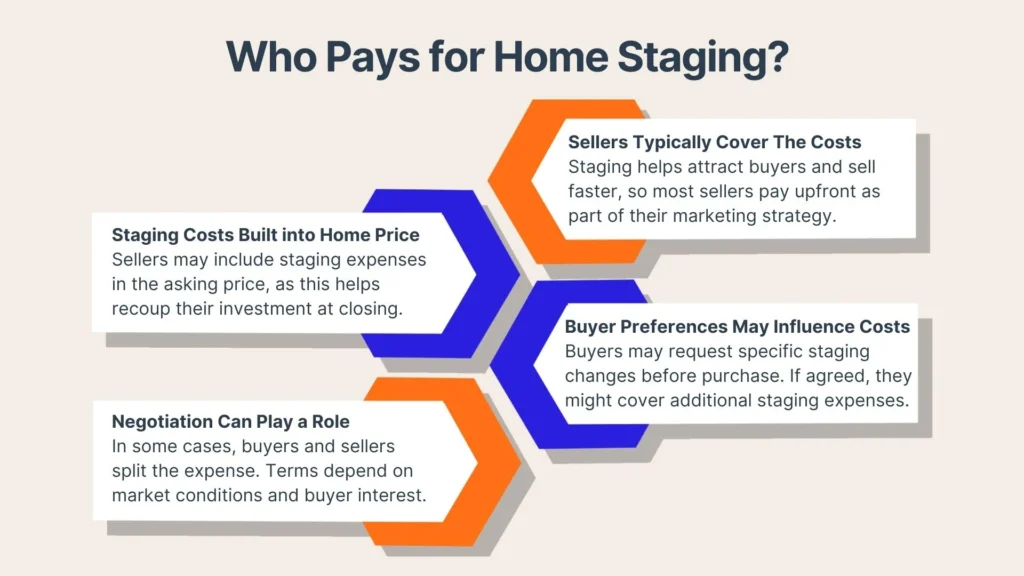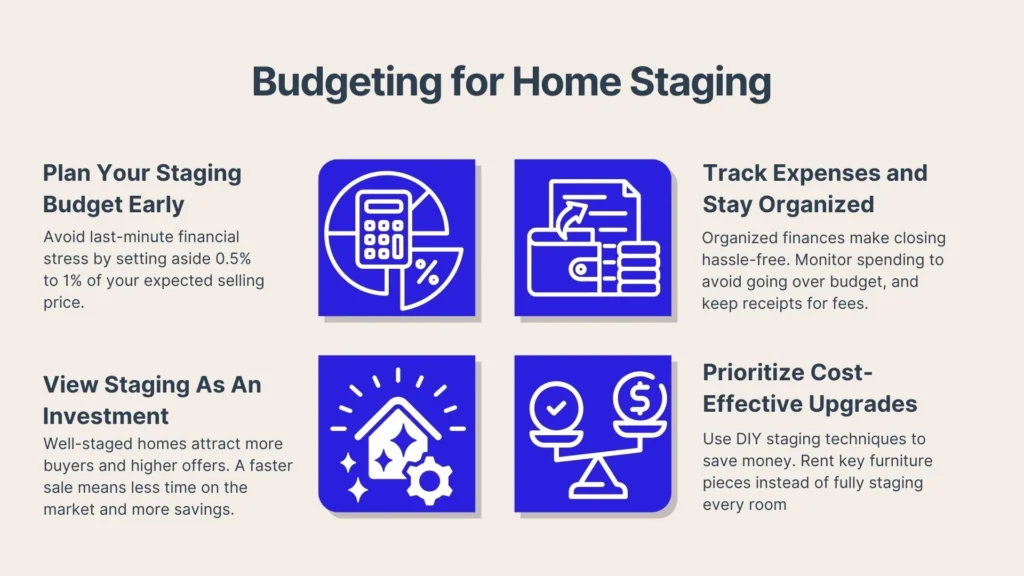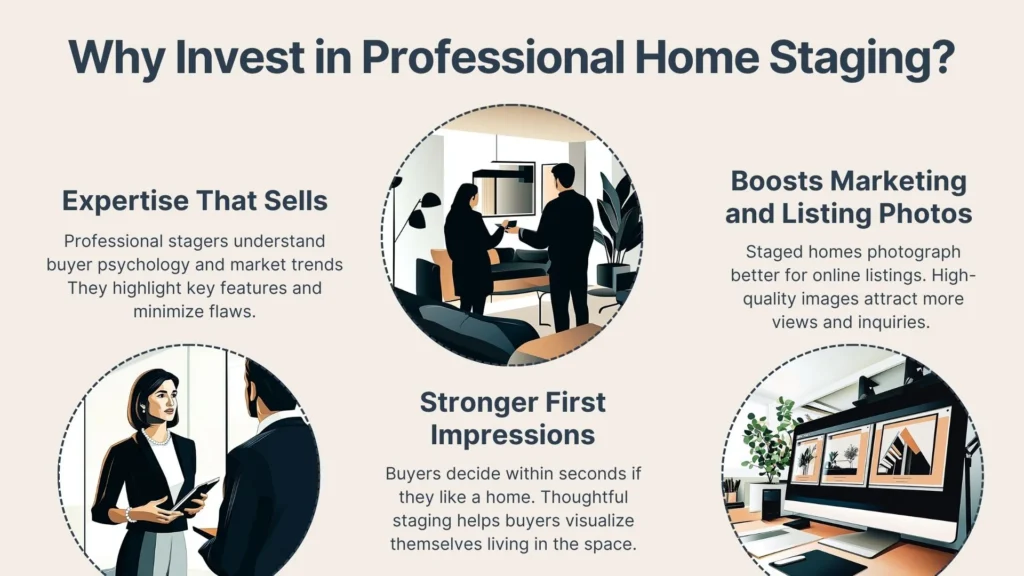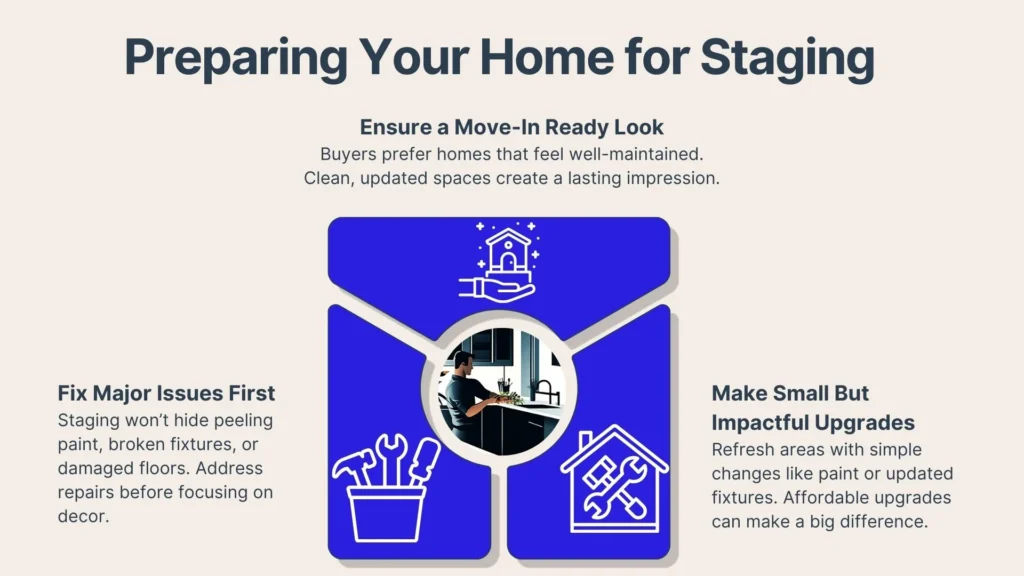Selling your home is an exciting experience, but it can also feel overwhelming as you strive to attract buyers and secure the best possible price. Many sellers don’t realize that home staging can be a game-changer, with studies showing it can boost sale prices by up to 10%.
It’s a powerful way to showcase your home’s potential and make a lasting impression on buyers. The big question is, who covers the cost, and how can you keep expenses under control? In this guide, we’ll break down what to expect, who typically pays for staging, and how to get the most value without overspending.
What Is Home Staging?
Home staging helps make your home more attractive to buyers. It’s more than just cleaning – it can include rearranging furniture, decluttering, and adding decor to help buyers picture themselves living there.
You can take the DIY route or hire a pro to showcase your home’s best features. The goal is to create a welcoming space that stands out from the competition.
Who Typically Pays For Home Staging?
Typically, home sellers cover the cost of staging since they're the ones trying to make the property more attractive to potential buyers. However, there are instances where buyers might indirectly contribute to the expense:

- Built into the Home Price: If a seller stages the home before listing and factors the cost into the asking price, the buyer essentially covers it as part of their purchase.
- Negotiations: During the sale process, a seller might ask the buyer to pitch in on certain closing costs, which could include staging if both parties agree.
- Buyer Preferences: In rare cases, a buyer might request specific staging adjustments like certain furniture or décor before finalizing their offer. If the seller agrees, the buyer could end up covering those additional costs.
At the end of the day, it depends on the deal and market norms, but in most cases, sellers take on staging costs upfront as part of their selling strategy.
How Can FSBO Sellers Manage Home Staging Costs?
Selling your home on your own can be both liberating and daunting. Without a real estate agent’s services, you get to keep more of the profit from the sale, but you’re also responsible for tasks like marketing, showings, and yes – staging. Here are some practical ways to handle staging costs when you’re flying solo.
Now that we’ve established the importance of budgeting for staging, let’s dive deeper into the specific tactics you can use. We’ll start with low-cost DIY strategies, then consider the pros and cons of hiring a professional stager, and finally look at how to budget effectively for your staging efforts.
DIY Staging Tips To Cut Expenses
If you’re on a tight budget or simply enjoy rolling up your sleeves, you can handle much of the staging process yourself:
- Decluttering and Cleaning: First impressions are everything. Go room by room, removing excess items, personal photos, and memorabilia that might distract buyers. Give each space a deep cleaning, as sparkling floors, counters, and fixtures can make a home feel well-cared for and move-in ready.
- Rearranging Furniture for Better Flow: Arrange furniture to create inviting conversation areas and open pathways. If you have bulky pieces, consider putting them in storage to make your rooms look more spacious.
- Adding Simple Decor Touches: Fresh flowers, potted plants, or tasteful wall art can breathe life into a space. Neutral colors and subtle accents often work best to appeal to the largest number of buyers.
DIY staging can be highly effective, but be sure to take a step back and view your home from a buyer’s perspective. Sometimes, asking friends for their honest opinions can help you spot areas that might need additional attention.
Hiring A Professional Stager
If your budget allows, hiring a professional stager can be a smart move. They know how to highlight your home’s best features and minimize any flaws. To get the best fit, compare quotes and check portfolios to find a style that matches your vision.
Some stagers offer packages that include furniture rental and design consultations, making it easier to stay within budget. Professional help is especially useful for tricky layouts or if you’re short on time to handle it yourself.
Budgeting For Staging

Budgeting early can help prevent last-minute stress when it comes to staging your home. Setting aside a small percentage of your anticipated selling price – usually between 0.5% and 1% – can be a smart way to cover staging costs without feeling overwhelmed.
Instead of seeing it as just another expense, think of staging as an investment that can pay off by attracting higher offers and helping your home sell faster. Keeping track of receipts and expenses, whether it’s for paint, furniture rentals, or a stager’s fee, ensures you stay on budget and keeps everything organized for a hassle-free closing.
Benefits Of Professional Home Staging
Professional home staging can transform a property into an eye-catching listing that appeals to a wide range of potential buyers. While DIY staging has its merits, there’s a reason many sellers see professional staging as a smart investment.
Let’s take a closer look at some of the ways professional staging can give your home a competitive advantage:

Brings Professional Expertise
A trained stager doesn’t just know how to place furniture; they understand buyer psychology and current market trends. They can identify which features to highlight and how to minimize flaws. This expertise can be invaluable if your house needs a little extra polish or if you’re selling in a highly competitive market.
Creates Better First Impressions
Buyers often decide whether they like a home within seconds of stepping inside. Professional stagers know this and aim to create a warm, welcoming atmosphere from the moment someone walks in. When every room is thoughtfully arranged and decorated, buyers are more likely to envision themselves living there.
Provides Effective Marketing Photos
In today’s online-focused world, photos are everything. A staged home will typically photograph better, which can make your online listing more appealing. Since most buyers begin their search on real estate websites, having scroll-stopping photos can significantly boost your listing’s visibility.
Alternatives To Traditional Home Staging
If traditional staging feels too pricey or too labor-intensive, consider alternatives that can still help your home stand out:
- Virtual Staging: Rather than physically moving furniture into your home, virtual staging involves using software to add digital furnishings and décor to photos of your vacant (or sparsely furnished) rooms. This can be especially useful if you’ve already moved out and want to showcase a space without the expense of renting furniture.
- Hybrid Approaches: Some sellers combine a bit of DIY work with virtual staging for online photos, plus a few real-life staging touches in key areas like the living room and kitchen. This can cut costs while still giving buyers a strong visual impression both online and during in-person showings.
While virtual options can be cost-effective, keep in mind that buyers will eventually see the home in person. Be prepared to make your real-life rooms look as inviting as possible, even if you’re not going all-in on full-scale staging.
Is Home Staging Worth The Cost?
The decision to stage – or how extensively to stage – depends on multiple factors, including your local market conditions, the condition of your home, and your competition. Some sellers realize a significant return on their investment in staging, while others may not find it as beneficial.
Let’s break down a few considerations to help you decide if staging is right for you:
Evaluating The Local Real Estate Market
Different markets have different expectations, and staging can play a key role in both fast and slow-moving markets.
In a seller’s market, it can help you attract higher offers, while in a buyer’s market, it can make your home stand out among the competition. Looking at recent sales in your area can give you a good idea of whether staging makes a difference – if staged homes sold faster or at higher prices, it’s likely worth considering.
It’s also important to think about your target buyer, whether they’re looking for a move-in-ready home or a fixer-upper, so you can tailor your staging efforts accordingly.
Considering The Condition Of The Home

Consider how much effort your home needs to look its best before diving into staging. Major repairs like peeling paint, broken fixtures, or damaged floors should be taken care of first, as staging won’t cover up obvious flaws.
If certain areas, like the kitchen or bathrooms, feel outdated, small upgrades such as painting cabinets or updating fixtures can add more value than just adding decorative touches. Focusing on these improvements first ensures your home feels well-maintained and ready to impress buyers.
Assessing Competition In The Area
With competing listings, standing out is important. Take a look at other listings to see if they’re staged, recently renovated, or freshly painted, and use that insight to position your home effectively.
Highlighting unique features like a larger yard, a new roof, or updated systems in your staging and marketing can give you an edge. In the end, deciding whether to stage comes down to balancing your budget and time with the potential return, as a well-staged home can often be the extra push buyers need to make an offer.
Conclusion
A well-staged home doesn’t just look great – it can sell faster and at a better price. While staging costs are typically covered by the seller, they’re an investment that can pay off significantly. Whether you tackle it yourself or work with professionals, making your home more inviting is crucial to standing out.
With PropBox, you can streamline the process further through virtual inspections that offer personalized recommendations and AI-driven virtual staging, helping buyers better visualize the space. Try PropBox today and let it help you make your home shine without stretching your budget!
